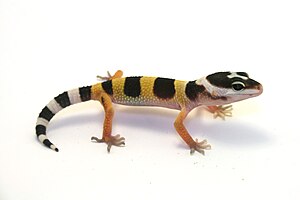It’s one of the first things all Leopard Gecko owners
learn: Don’t use sand as a substrate.
I’m sure you experienced owners already know this. But
if you’re new to the Leopard Gecko care scene, make sure you stay away from
sand as a substrate if at all possible. It’s quite easy for Leopard
Geckos to suffer from impaction when housed on sand, even calcium sand.
This is especially true when they’re younger. They ingest some of the
sand as they hunt, and sometimes even purposely if they feel deprived of
minerals like calcium. This sand blocks their digestive tract causing
major health problems and even death.
Artemis was originally housed on sand for 2 weeks until we
were able to get some suitable tile for the bottom of her habitat. Now
she happily lives on a combination of half tile and half reptile carpet.
We’d suggest using either reptile carpet or tile as a
substrate. Reptile carpet is great, but sometimes causes the geckos to
snag their teeth while hunting. Tile is great, but must be carefully
installed. You want a tile with texture, not a smooth surface. You
also have to be careful there aren't any sharp edges on the tiles. And
finally, you have to make sure that the tile is holding the appropriate
temperature. Use a thermometer to monitor it, and even a thermostat to
help control under tank heaters and lamps. Use multiple layers of thinner
tiles if necessary.
Getting the proper substrate installed in the habitat is the
first step to providing your Leopard Gecko with a great habitat in which to
live. Want to learn more about animals? Check out my other
horse site.











